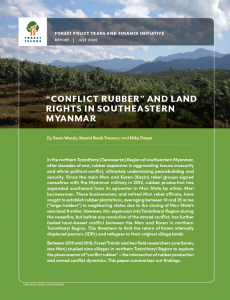“Conflict Rubber” and Land Rights in Southeastern Myanmar
By Kevin Woods, Naomi Basik Treanor, and Mike Dwyer View PublicationIn the northern Tanintharyi (Tenasserim) Region of southeastern Myanmar,
after decades of war, rubber expansion is aggravating tenure insecurity
and ethnic political conflict, ultimately undermining peacebuilding and
security. Since the main Mon and Karen (Kayin) rebel groups signed
ceasefires with the Myanmar military in 2012, rubber production has
expanded southward from its epicenter in Mon State by ethnic Mon
businessmen. These businessmen, and retired Mon rebel officers, have
sought to establish rubber plantations, averaging between 10 and 25 acres
(“large-holders”) in neighboring states due to the closing of Mon State’s
own land frontier. However, this expansion into Tanintharyi Region during
the ceasefire, but before any resolution of the armed conflict, has further
fueled land-based conflict between the Mon and Karen in northern
Tanintharyi Region. This threatens to limit the return of Karen internally
displaced persons (IDPs) and refugees to their original village lands.
Between 2015 and 2016, Forest Trends and two field researchers (one Karen,
one Mon) studied nine villages in northern Tanintharyi Region to explore
the phenomenon of “conflict rubber” – the intersection of rubber production
and armed conflict dynamics. This paper summarizes our findings.

